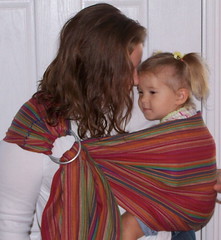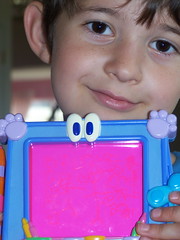It's that time again. I already have one Fyrebranded Kozy up for auction, this is a preview of one that will be ready at the end of the week. Inspired by my time looking out our upstairs window while living in Hawaii, I wanted a moonscape, yet I kept the colors the sea breathes during the daytime:
10.22.2006
Moonscape
at 13:40 2 i wanna add my .02!
Labels: babywearing, create, fabric art, Fyrebranded Kozy, Kozy, ocean
10.21.2006
Here we go again...
I decided on a simpler Fyrebranded Kozy this time. It's a panel, the hardest part was getting the dye right. Why so simple? Because I have a harder one set out, waiting for the onerous job of stitching every line ;)
The colors are very much richer IRL:
at 21:16 0 i wanna add my .02!
Labels: accomplishments, babywearing, create, fabric art, Fyrebranded Kozy
10.16.2006
Gotta Love Dove!
http://www.boardsmag.com/screeningroom/commercials/3421/
There are more and more "the man behind the curtain" sites these days, but I think this video from Dove really makes it real, esp. for the younger crowd. What got me is the photo editing of an already beautiful woman.
I shudder to think that my daughter will grow up in a world that compares her to these hybrid cyber-models. I can only hope the pendulum is swinging the other way- and soon.
Other before/after sites:
http://www.fluideffect.com/ (Select potfolio and then before and after)
http://homepage.mac.com/gapodaca/digital/bikini/bikini1.html
http://demo.fb.se/e/girlpower/
at 08:36 1 i wanna add my .02!
Labels: being true, expectations, fake, metamorphosis, real beauty
10.05.2006
the string around my finger
a la peanut butter sandwiches

I wish I could just do that and take care of things. I am so tired of the day in day out taking care of other people- other people who seem bent on undoing everything I accomplish.
Never a clean house
Never a full nights sleep
Never a request listened to
Never alone
It's the last one that gets to me. I'm never alone yet usually lonely. I don't have whatever connections I need to feel complete. And yes, this is a bad day. It's worse because there have been so many good days lately. But I am so tired and feel so behind. I don't get at all why I can't do what the other moms can. What is lacking in me that doesn't desire to spend more time just entertaining these hairless monkeys?
Not to mention I start a thousand diets a day, only to 'reward' myself with a treat for being patient, or to swallow food when I am frustrated. I want to be beautiful inside and out, but I feel like neither.
I have dreams of homeschooling, living an environmentally friendly life, being able to invite people in without having to shove things in corners, bedtimes, alone times, just feeling for once I am caught up and it will stay that way for a day. Instead, I just feel stuck.
at 14:39 0 i wanna add my .02!
Labels: bad parenting, sour grapes
Carry Me! Good for you, good for your baby. So why don’t we do it more?
I am 'reprinting' the following article, because often articles like this vanish from cyberspace.
| Carry Me! |
| Good for you, good for your baby. So why don’t we do it more? |
| By Teresa Pitman |
Lenore Kilmartin is convinced that carrying her baby saved his life. “OK, maybe the doctors who did the surgery also had something to do with it,” she concedes. “But I have no doubts that being carried around helped him.”
Liam, her fifth child, seemed healthy and normal at birth. Kilmartin took care of him just as she had her older children, carrying him in a sling or soft carrier most of the day while she did housework, went shopping and helped her other children.
“He did seem a little quieter than the others, but I thought that was just his personality,” she comments. “He nursed frequently but for short times — and that was easy to do with the sling.”
During a visit to the doctor when Liam was five months old, Kilmartin was shocked to discover that he had a serious heart defect. They went straight from their family doctor’s office to a paediatric heart specialist. The diagnosis? Liam had four holes in his heart and would need surgery to repair them.
“The doctor asked me, ‘Didn’t you notice his lips turning blue when he cried?’” Kilmartin recalls. “And I realized that he really never cried. He was always close to me, so if he started to fuss or squirm around, I could quickly shift his position or burp him or nurse him if that was what he wanted. He really never got to the point of crying hard.”
The doctor was also very impressed by Liam’s weight gain. “Most babies with heart problems like Liam’s, because they tire so easily, have problems gaining weight,” Kilmartin explained. “But Liam never tired himself out with crying, so his weight gain was very good. That meant he went into his surgery in good shape.”
He also made a rapid recovery — heading home six days after the operation. “I tucked him back into the sling and he continued to do well,” Kilmartin says.
Being carried has also been shown to be helpful to tiny premature babies. With these infants, it’s often called “kangaroo care” because it mimics the way mother kangaroos carry their babies in a pouch until the joey is more mature. The system originated in Colombia, South America, but research shows that when premature babies are carried in an upright position, skin to skin with their parents, they gain weight better, maintain body temperature and have better breathing and heart rates. Just as important, the parents feel a stronger attachment to the babies they have carried, and are less likely to abuse or neglect them.
Carrying may be good for babies with health problems, but what about normal, healthy infants? Is it a good idea, or will it spoil the baby?
Happy or Spoiled?
Harvey Karp, a California paediatrician and author of The Happiest Baby on the Block, suggests we should consider that all babies are really born “prematurely” — at least compared to most other newborn animals.
“It’s as though we made a contract with our babies,” he explains. “Human babies have large brains that continue to grow through the first years, and in order for the baby’s head to fit through the mother’s pelvis, it needs to be born while it is still pretty undeveloped. So the deal was, the baby promised to come out early and we promised to imitate a uterus. That means giving the baby the constant contact, movement and soothing sounds that would be part of the uterine environment.”
Karp adds: “The problem is that some parents are trying to wiggle out of the agreement. And babies let us know they’re not happy with us not keeping our part of the bargain the only way they can — by crying.”
Ronald Barr, professor of paediatrics at the University of British Columbia, says the link between carrying and reduced crying is very clear. He first discovered this in a 1986 study, where an extra two hours of carrying each day reduced the overall amount of crying by 43 percent.
Carrying a baby seems to make some other aspects of caregiving easier, which may reduce crying as well, says Barr. For example, the !Kung San in Africa — who carry their infants almost all the time — respond to every fret or whimper the baby makes within 10 seconds. That’s a lot easier to do when the baby is right there with you, not a wailing sound from upstairs heard through a baby monitor.
How important that quick response is may depend somewhat on your baby’s temperament. Barr cites research which showed that babies who were described as “irritable” — sensitive and intense in their responses — cried much less when their parents responded to them immediately and appropriately. Speed was important — if it took a long time for someone to arrive, these irritable infants became very hard to soothe.
Despite the clear benefits of carrying, Barr’s research shows that, in North America at least, babies are now being carried less, not more. “There is good data to show that our babies are spending more time in car seats and strollers, and less time in body contact with parents.”
Recent research by Barr, not yet published, looked at five-month-old babies in the province of Quebec. Barr recorded the total amount of “contact time” the babies had with their parents or caregivers over a period of 24 hours. This included feeding, diaper changing, dressing, bathing, carrying and holding — and the average was six hours. “That seems very low to me,” says Barr.
And it is much lower than in many countries around the world. Cathy Baldizon, a mother of two boys who formerly worked with CARE, says that when her family was living in Guatemala, the Mayan women carried their babies almost all the time, tied to their bodies with large shawls. “One day I was looking at a book that had photos of Asian women carrying their babies tied in shawls,” Baldizon recalls. “I showed the pictures to my Guatemalan friends, pointing out that these women carried their babies just like they did. Their reaction was puzzlement: ‘What’s the big deal? Don’t all mothers carry their babies this way?’ The idea that a mother wouldn’t carry her baby was just unimaginable to them.”
So why don’t more Canadian parents carry their babies? Barr says: “I think it is almost a side effect of the campaign to get babies into car seats in cars, which has been very successful. It just seems convenient to parents to move the baby around in the car seat even when they aren’t in the car, now that the seats have handles or can be popped into a stroller.”
Tonya Brock, the mother of two-year-old Lindsay and four-year-old Jason, says: “It’s the spoiling thing. I think people are worried that their babies won’t ever become independent or be able to separate if they carry them too much when they are babies. Certainly a lot of people said that to me when I was carrying Jason and Lindsay.”
Barr has heard similar comments. “Whenever I talk about the !Kung San people and how they carry their babies constantly and respond to them immediately, the first question I get is ‘Don’t they all grow up to be wimps?’ The answer to that is a very clear NO! There is no way you can consider these people to be wimps! Just to give one example — the !Kung San mothers give birth without any help and without crying out from pain. There are many more examples of their strengths.”
Barr also mentions a study done by Marjorie Elias, which compared babies of La Leche League leaders in the Boston area to other mothers. Barr says, “She found that the babies in the LLL group — who were carried more, responded to more quickly and nursed more frequently — did not become more demanding or cry more as they got older. They did not show any more ‘spoiled’ behaviours than the control group.”
Brock has also had people tell her, “The baby looks so uncomfortable,” when they saw Jason or Lindsay curled up in the sling. Once when she was walking quickly through an airport and carrying Lindsay, a woman stopped her and said, “You’re going to make your baby sick by jiggling her so much.”
Joan Grusec, professor of psychology at the University of Toronto, says parents shouldn’t worry about spoiling babies. “Babies most often cry because they are distressed in some way,” Grusec explains, “and physical contact is soothing and beneficial. The spoiling comes when the crying is deliberately used as a way of getting something else, such as attention. This is more likely to happen as children grow older. But carrying a baby in arms, a sling or soft carrier is a good idea — it provides both comfort and stimulation for the baby.”
The Carrying Continuum
Grusec adds that, in general, our culture doesn’t encourage parents to carry babies. She points out that “different cultures have different goals.” Close body contact for infants tends to be prevalent in cultures that value group harmony and interdependence. Other cultures value separation and autonomy — and Canada seems to fit into the second category.
“North American parents tend to use more visual contact and play with objects, and this is seen as facilitating greater separation,” Grusec explains.
Of course, Canadian society is by no means a homogeneous mixture, like a puréed soup. We’re more like a stew with a variety of different foods, so we have some parents who carry their babies a lot because of their cultural background or philosophy of parenting, others who carry them some of the time, and others who rarely take them in arms. These parents may have different aspirations for their children, different child-rearing goals. As Grusec says: “Parents are comfortable with different things. There are many ways of raising children (including whether or not to carry them) and, within reasonable limits, most things work.”
The baby’s temperament may be a factor too in determining whether or not the baby gets carried. If carrying is the best — or only — way to soothe your crying baby, you may end up doing it a lot even if it wasn’t part of your planned approach to parenting. Tonya Brock says that easygoing Lindsay would probably be fine with less carrying, but Jason was a different story. “He was very fussy as a baby — not only did he need to be carried, but he needed me to keep moving,” she recalls. “Carrying him was the only way we could both be happy.”
When Brock returned to work seven months after Jason’s birth, she spent quite a bit of time searching for a daycare provider who would continue to carry Jason. “I think the fact that Chantelle was willing to hold him made a big difference in how he adjusted to being in daycare,” Brock says.
Sometimes carrying is just the practical way to go. With Jason a very active toddler when Lindsay was born, Brock found a carrier for her daughter was a very practical accessory. “It left my hands free to get work done, and I didn’t have to worry about leaving her behind to chase after Jason.”
So should parents carry their babies more? Barr has a lot of trouble with the word “should.”
All other things being equal, the more body contact time you have with your baby, the better,” he says. “If you can carry your baby more, you will both benefit because your baby will cry and fuss a lot less. But I also recognize that people may have important reasons that prevent them from carrying their babies, and so it can be a trade-off. The baby who is carried less will cry more, but will grow up just fine.”
In the end, Brock and Kilmartin both say they carried their babies “because it felt right.” Brock adds: “There is something about the feel of their little bodies and the way they mould themselves to you and relax. It’s just such a good feeling.”
The babies think so too.
Carrying Your Baby:
The Practical Side
The right carrier can save your back and free up your hands. You might have to do a little experimenting to find one you really like. Ask friends if you can try theirs out before investing a lot of money — and be sure to check second-hand stores.
Slings are popular and are great for discreet breastfeeding; or consider a wrap, which is a long piece of cloth that can be wrapped in different ways to hold your baby in place.
Try to find someone who can show you how to use your carrier in different positions. You’ll soon learn which your baby prefers.
When’s a good time to carry your baby? Anytime. But if your baby is fussy at a particular time of day — such as the evening — it seems to work better to start carrying the baby an hour or two before he gets fussy.
Originally published in Today's Parent, Pregnancy & Birth, Spring 2005
at 14:33 0 i wanna add my .02!
Labels: babywearing





